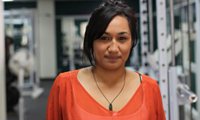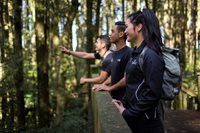Apakura te Kākano team lead Kim Redshaw and tamariki learning about their environment.
Te Wānanga o Aotearoa Ngā Puna Whakatupu are working with researchers to explore how to nurture tamariki as kaitiaki of their environment.
Te Puna Whakatupu o Apakura te Kākano in Te Awamutu and Te Puna Whakatupu o Te Rau Ōriwa in Tokoroa are working alongside researchers from The University of Waikato.
Their two-year rangahau project, set to start in February through 2017 and 2018, will ask what tikanga Māori tamariki already know, can learn and enact to become kaitiaki (guardians) of and for their environment.
It’s hoped the intervention-based rangahau in which tamariki interact with their immediate environment will also develop kaitiakitanga principles to guide Māori environmental sustainability and these materials will be shared with other ECE services and the wider educational community.
It will also look at whether mātauranga Māori makes a difference for childrens’ wellbeing and learning.
Tamariki in Tokoroa will be immersed with a local ngāhere while the children at Apakura Te Kākano are looking to replenish a nearby swamp.
Lucille Haupokia, a kaiako at Apakura te Kākano, said the puna was about to approach the landowners of the swamp area to the rear of Te Puna Mātauranga to put forward their kaitiaki proposal.
“We want to meet with the landowners and put forward our proposal that our tamariki will be the kaitiaki of this area.”
Lucille said tamariki would learn pūrākau about the swamp, which was re-planted some years ago to prevent flooding during heavy rains with kauri, rimu, totara and other native plants.
The water quality in the stream is also variable at times so improving it will also be a focus.
“There used to be eels in the stream there and children would go there to catch them so we are wanting to replenish the water quality there so they come back and the soil so we can replant trees and shrubs,” said Lucille.
“We want to improve things but will be asking questions about how do we do that – all of this is focused on kaitiakitanga and getting our children involved.”
Whānau of tamariki at the puna are also invited to be involved with the project allowing the children to follow their kaiako and parents and learn through observation, imitation and discussion.
A video diary will capture the process including environmental learning experiences and whānau discussions while the tamariki will also record their learning through story-writing.
The university researchers from the Faculty of Education Lesley Rameka and Vanessa Paki said indigenous cultural beliefs and knowledge had been shown to contribute to long-term sustainable use of resources, especially in relation to maintaining ecosystem resilience.
-
 Kāinga
Home
Kāinga
Home
-
 Kāinga
Home
Kāinga
Home
-
Ngā ĀkorangaOur Programmes
Ngā Ākoranga - Our Programmes
-
Ngā RoheOur Locations
Ngā Rohe - Our Locations : Main Service Centres
-
Ngā TauiraStudents
Ngā Tauira - Students
- HonongaStay Connected
- Te WhareAbout Us



































